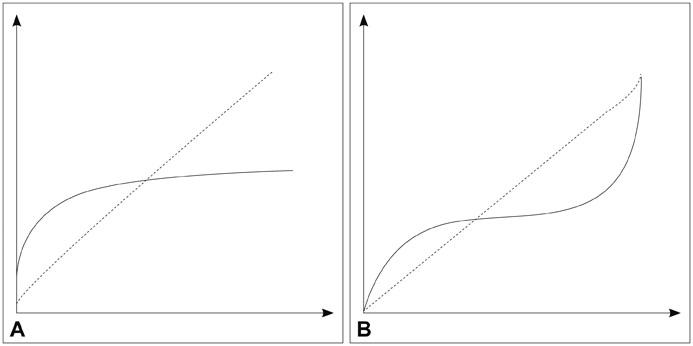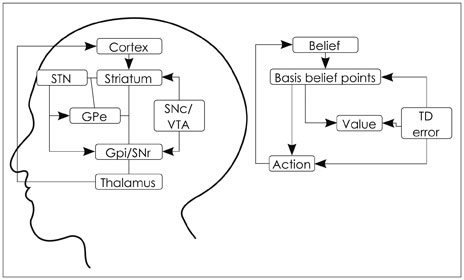J Korean Neuropsychiatr Assoc.
2015 Aug;54(3):282-290. 10.4306/jknpa.2015.54.3.282.
The Effect of Depression in Decision Making Process : Based on Quantitative Methodology
- Affiliations
-
- 1The Catholic University of Korea College of Medicine, Seoul, Korea.
- 2Department of Psychiatry, The Catholic University of Korea College of Medicine, Seoul, Korea. alberto@catholic.ac.kr
- KMID: 2035961
- DOI: http://doi.org/10.4306/jknpa.2015.54.3.282
Abstract
- The increasing number of patients with depression is a serious social issue in contemporary Korean society. To fully understand the pathophysiology of depression, this paper reviewed how depression affects the decision making process of humans. Various recent studies in behavioral economics, mathematics, medicine, and neurobiology have shown how humans make decisions and how emotional disturbances, such as depressive disorder, affect this process. There has been great progress in behavioral economics during this decade, and numerous experiments have been designed to evaluate decision making process in humans. In general, economic decision making is evaluated using the Iowa Gambling Task, and social decision making is assessed using the ultimatum game. Numerous research studies have analyzed the performance and reaction of patients with depression in these games. As a result of the advancement of neurophysiology, research has successfully identified the part of the brain that causes the specific results of tests being conducted on patients with depression. Meanwhile, computational neuroscientists have established decision making models based on bayesian framework. These models also match with the neuroanatomy. Although a large part remains unclear, researchers look forward to achieving a better understanding in depression by analyzing the distinct patterns of responses that patients under depression show in the experiment of behavioral economics.
MeSH Terms
Figure
Reference
-
1. Bechara A. The role of emotion in decision-making: evidence from neurological patients with orbitofrontal damage. Brain Cogn. 2004; 55:30–40.
Article2. Rangel A, Camerer C, Montague PR. A framework for studying the neurobiology of value-based decision making. Nat Rev Neurosci. 2008; 9:545–556.
Article3. Paulus MP. Decision-making dysfunctions in psychiatry--altered homeostatic processing? Science. 2007; 318:602–606.
Article4. Walton ME, Behrens TE, Noonan MP, Rushworth MF. Giving credit where credit is due: orbitofrontal cortex and valuation in an uncertain world. Ann N Y Acad Sci. 2011; 1239:14–24.
Article5. Mellers BA, Biagini K. Similarity and choice. Psychol Rev. 1994; 101:505–518.
Article6. Hsee CK, Rottenstreich Y. Music, pandas, and muggers: on the affective psychology of value. J Exp Psychol Gen. 2004; 133:23–30.
Article7. Rottenstreich Y, Hsee CK. Money, kisses, and electric shocks: on the affective psychology of risk. Psychol Sci. 2001; 12:185–190.
Article8. Rudebeck PH, Walton ME, Smyth AN, Bannerman DM, Rushworth MF. Separate neural pathways process different decision costs. Nat Neurosci. 2006; 9:1161–1168.
Article9. Maule AJ, Hockey GR, Bdzola L. Effects of time-pressure on decision-making under uncertainty: changes in affective state and information processing strategy. Acta Psychol (Amst). 2000; 104:283–301.
Article10. Tversky A, Kahneman D. Availability: a heuristic for judging frequency and probability. Cogn Psychol. 1973; 5:207–232.
Article11. Rilling JK, Sanfey AG. The neuroscience of social decision-making. Annu Rev Psychol. 2011; 62:23–48.
Article12. Paulus MP, Yu AJ. Emotion and decision-making: affect-driven belief systems in anxiety and depression. Trends Cogn Sci. 2012; 16:476–483.
Article13. Mayberg HS. Limbic-cortical dysregulation: a proposed model of depression. J Neuropsychiatry Clin Neurosci. 1997; 9:471–481.
Article14. Yang Y, Raine A. Prefrontal structural and functional brain imaging findings in antisocial, violent, and psychopathic individuals: a meta-analysis. Psychiatry Res. 2009; 174:81–88.
Article15. Winkielman P, Knutson B, Paulus M, Trujillo JL. Affective influence on judgments and decisions: moving towards core mechanisms. Rev Gen Psychol. 2007; 11:179–192.
Article16. Ekman P. Are there basic emotions? Psychol Rev. 1992; 99:550–553.
Article17. Lerner JS, Keltner D. Fear, anger, and risk. J Pers Soc Psychol. 2001; 81:146–159.
Article18. Kahneman D. A perspective on judgment and choice: mapping bounded rationality. Am Psychol. 2003; 58:697–720.
Article19. Kahneman D, Tversky A. Prospect theory: an analysis of decision under risk. Econometrica. 1979; 47:263–291.
Article20. Mukherjee K. A dual system model of preferences under risk. Psychol Rev. 2010; 117:243–255.
Article21. Kusev P, van Schaik P. Preferences under risk: content-dependent behavior and psychological processing. Front Psychol. 2011; 2:269.
Article22. Kusev P, van Schaik P, Ayton P, Dent J, Chater N. Exaggerated risk: prospect theory and probability weighting in risky choice. J Exp Psychol Learn Mem Cogn. 2009; 35:1487–1505.
Article23. Vlaev I. Inconsistency in risk preferences: a psychophysical anomaly. Front Psychol. 2011; 2:304.
Article24. Platt ML, Huettel SA. Risky business: the neuroeconomics of decision making under uncertainty. Nat Neurosci. 2008; 11:398–403.
Article25. Battaglia PW, Jacobs RA, Aslin RN. Bayesian integration of visual and auditory signals for spatial localization. J Opt Soc Am A Opt Image Sci Vis. 2003; 20:1391–1397.
Article26. Green DM, Swets JA. Signal detection theory and psychophysics. Los Altos, CA: John Wiley & Sons;1974. p. 10–94.27. Körding KP, Wolpert DM. Bayesian integration in sensorimotor learning. Nature. 2004; 427:244–247.
Article28. Behrens TE, Woolrich MW, Walton ME, Rushworth MF. Learning the value of information in an uncertain world. Nat Neurosci. 2007; 10:1214–1221.
Article29. Rao RP. Decision making under uncertainty: a neural model based on partially observable markov decision processes. Front Comput Neurosci. 2010; 4:146.
Article30. Pizzagalli DA. Frontocingulate dysfunction in depression: toward biomarkers of treatment response. Neuropsychopharmacology. 2011; 36:183–206.
Article31. Bechara A, Damasio AR, Damasio H, Anderson SW. Insensitivity to future consequences following damage to human prefrontal cortex. Cognition. 1994; 50:7–15.
Article32. Smoski MJ, Lynch TR, Rosenthal MZ, Cheavens JS, Chapman AL, Krishnan RR. Decision-making and risk aversion among depressive adults. J Behav Ther Exp Psychiatry. 2008; 39:567–576.
Article33. Han G, Klimes-Dougan B, Jepsen S, Ballard K, Nelson M, Houri A, et al. Selective neurocognitive impairments in adolescents with major depressive disorder. J Adolesc. 2012; 35:11–20.
Article34. von Helversen B, Wilke A, Johnson T, Schmid G, Klapp B. Performance benefits of depression: sequential decision making in a healthy sample and a clinically depressed sample. J Abnorm Psychol. 2011; 120:962–968.
Article35. Bearden JN, Rapoport A, Murphy RO. Sequential observation and selection with rank-dependent payoffs: an experimental test. Manag Sci. 2006; 52:1437–1449.
Article36. Strunk DR, Adler AD. Cognitive biases in three prediction tasks: a test of the cognitive model of depression. Behav Res Ther. 2009; 47:34–40.
Article37. Bless H, Bohner G, Schwarz N, Strack F. Mood and persuasion: a cognitive response analysis. Pers Soc Psychol Bull. 1990; 16:331–345.38. Gleicher F, Weary G. Effect of depression on quantity and quality of social inferences. J Pers Soc Psychol. 1991; 61:105–114.
Article39. Andrews PW, Thomson JA Jr. The bright side of being blue: depression as an adaptation for analyzing complex problems. Psychol Rev. 2009; 116:620–654.
Article40. Jollant F, Bellivier F, Leboyer M, Astruc B, Torres S, Verdier R, et al. Impaired decision making in suicide attempters. Am J Psychiatry. 2005; 162:304–310.
Article41. Foti D, Hajcak G. Depression and reduced sensitivity to non-rewards versus rewards: evidence from event-related potentials. Biol Psychol. 2009; 81:1–8.
Article42. Bronisch T, Wittchen HU. Suicidal ideation and suicide attempts: comorbidity with depression, anxiety disorders, and substance abuse disorder. Eur Arch Psychiatry Clin Neurosci. 1994; 244:93–98.
Article43. Chase HW, Camille N, Michael A, Bullmore ET, Robbins TW, Sahakian BJ. Regret and the negative evaluation of decision outcomes in major depression. Cogn Affect Behav Neurosci. 2010; 10:406–413.
Article44. Pizzagalli DA, Bogdan R, Ratner KG, Jahn AL. Increased perceived stress is associated with blunted hedonic capacity: potential implications for depression research. Behav Res Ther. 2007; 45:2742–2753.
Article45. Nakano M, Matsuo K, Nakashima M, Matsubara T, Harada K, Egashira K, et al. Gray matter volume and rapid decision-making in major depressive disorder. Prog Neuropsychopharmacol Biol Psychiatry. 2014; 48:51–56.
Article46. Forbes EE, Christopher May J, Siegle GJ, Ladouceur CD, Ryan ND, Carter CS, et al. Reward-related decision-making in pediatric major depressive disorder: an fMRI study. J Child Psychol Psychiatry. 2006; 47:1031–1040.
Article47. Güth W, Schmittberger R, Schwarze B. An experimental analysis of ultimatum bargaining. J Econ Behav Organ. 1982; 3:367–388.
Article48. Scheele D, Mihov Y, Schwederski O, Maier W, Hurlemann R. A negative emotional and economic judgment bias in major depression. Eur Arch Psychiatry Clin Neurosci. 2013; 263:675–683.
Article49. Destoop M, Schrijvers D, De Grave C, Sabbe B, De Bruijn ER. Better to give than to take? Interactive social decision-making in severe major depressive disorder. J Affect Disord. 2012; 137:98–105.
Article50. Kerr N, Dunbar RI, Bentall RP. Theory of mind deficits in bipolar affective disorder. J Affect Disord. 2003; 73:253–259.
Article51. Inoue Y, Yamada K, Kanba S. Deficit in theory of mind is a risk for relapse of major depression. J Affect Disord. 2006; 95:125–127.
Article52. Kampman O, Poutanen O. Can onset and recovery in depression be predicted by temperament? A systematic review and meta-analysis. J Affect Disord. 2011; 135:20–27.
Article53. Harlé KM, Allen JJ, Sanfey AG. The impact of depression on social economic decision making. J Abnorm Psychol. 2010; 119:440–446.
Article54. Wang Y, Zhou Y, Li S, Wang P, Wu GW, Liu ZN. Impaired social decision making in patients with major depressive disorder. BMC Psychiatry. 2014; 14:18.
Article55. Crockett MJ, Clark L, Hauser MD, Robbins TW. Serotonin selectively influences moral judgment and behavior through effects on harm aversion. Proc Natl Acad Sci U S A. 2010; 107:17433–17438.
Article
- Full Text Links
- Actions
-
Cited
- CITED
-
- Close
- Share
- Similar articles
-
- Public Health Nurses' Decision Making Models and Their Knowledge Structure
- Shared Decision Making in Geriatric Care
- The Pattern of Decision Making to Donate a Living Kidney
- The Effect of Depression and Smartphone Dependency on Female College Students' Career Decision-making Self Efficacy
- Brain-based medical education model for expert’s clinical decision making




